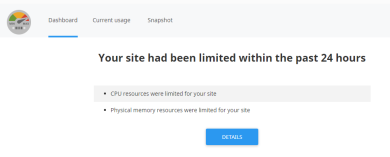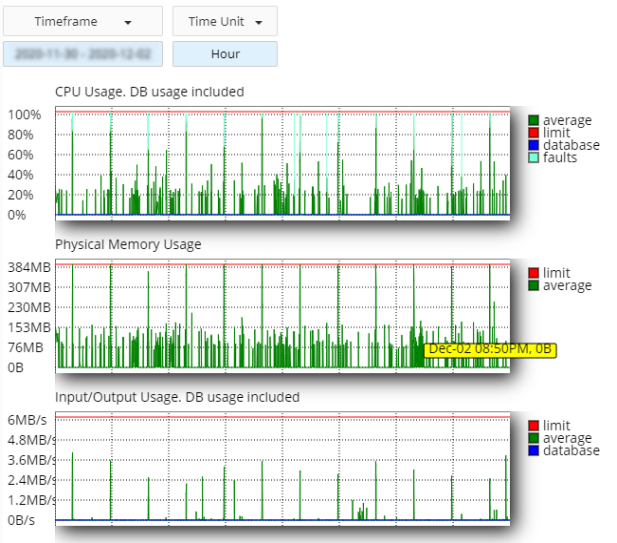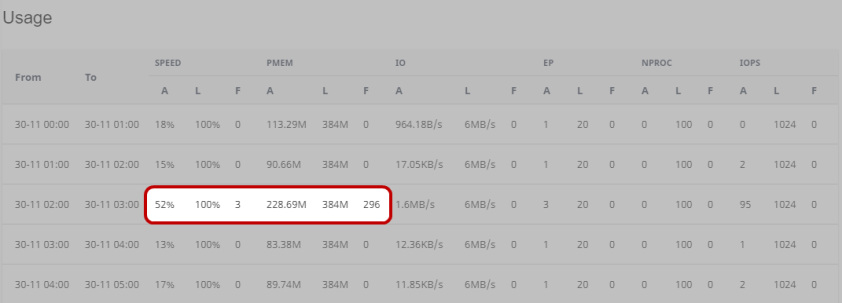Viewing Resource Usage
Resource Usage for your Hosting Plan can be accessed via the Resource Usage link in the top right area of your Hosting Control Panel.
See also: Accessing your Hosting Account Control Panel
If your hosting plan has exhausted the available resources at any point in the last 24 hours, you will be presented with a notice such as the one picture below.

By clicking either Details or Current usage you will be able to view and filter the resource usage of your hosting plan. Usage will be presented in both graphical and table format, as illustrated below

The graphs also show the average, limit and fault entries from the specific time frame

Prefix A, Land F stand for Average, Limit and Faults.
Faults occur when the available resources for that category are exhausted. In the example table above, this hosting plan experienced a peak where both SPEED and PMEM resources were exhausted. Additionally, in looking at the graphs, a clear pattern of resource usage is quite apparent. Such a pattern is not a result of site visitor traffic, but rather of automated processes that the website is performing. In the case of CMS platforms such as WordPress, automated processes can include scheduled actions performed automatically by plugins.
Please see the resource section below for more information on each type of resource your hosting plan can consume.
Resources
SPEED
CPU Limit
CPU usage reflects processes and activity occurring on your website. The loading of a simple webpage would require little CPU resources, while the loading of a complex script or other activities can consume relatively more. Pages with multiple types of functionality will require multiple processes and thus higher CPU resources to work properly. The amount of CPU resources being consumed by a website at any given time is a factor of both website complexity and number of concurrent visitors.
PMEM
Memory Usage
Each process running on your website will consume memory. Some memory consumption will occur for each visitor to your website, as they load pages and interact with content. Additional memory consumption will occur during administrative or automated tasks, such as image resizing and general content creation, mail campaigns, and backups. Busier websites will have higher physical memory requirements. Websites with a large number of plugins will also require additional physical memory.
IO
DiskI/O Rate
Disk i/o (short for Input / Output) reflects data being read and written to disk by your website code. Most disk i/o for a website occurs in the form of the loading data from disk and presenting it to your website visitor. Large images and video will consume relatively high amounts of disk i/o resources. Therefore, the loading of a simple webpage will require little disk i/o resources, while loading a page with heavy multimedia content will consume significantly more. The amount of disk i/o resources being consumed by a website at any given time is a factor of both website page content size multiplied by the number of concurrent visitors loading that page content.
EP
Concurrent website connections
Each connection to your website represents a visitor actively engaging with your website (clicking links, loading pages etc.). Concurrent connections are then the cumulative total of the simultaneous actions being performed by all visitors on your website. Actions being taken by administrators on the backend of your website will also contribute to the connection count. Busier websites will see higher concurrent connection counts, and thus require a hosting plan with higher resources.
NPROC
Concurrent processes
Processes reflect activity occurring on your website. They are analogous to programs or applications running on your computer. Different tasks require different processes/programs. The loading of a simple webpage would require a process to perform that action, as would loading a script or any number of other activities that can occur on a website. Pages with multiple types of functionality will require multiple processes to work properly. The activity of visitors on your website will require the necessary processes to run in order for the related webpages to work as intended. Therefore, the number of processes occurring on a website at any given time is a factor of both website complexity and number of concurrent visitors.
IOPS
Concurrent I/O Operations
I/O (short for Input / Output) Operations reflect the number of processes of your website code attempting to write or read data from disk. Most i/o operations for a website occur in the form of the loading data from disk and presenting it to your website visitor. Large quantities of images or other data stored on disk can cause a high number of I/O operations, since the loading of such data would ideally occur all at once when such a page is loaded by a visitor. . The loading of a simple webpage would require little disk i/o operations, while the loading of a complex page would consume relatively more. Therefore, the amount of disk i/o operations being consumed by a website at any given time is a factor of both webpage complexity and number of concurrent visitors loading that page.